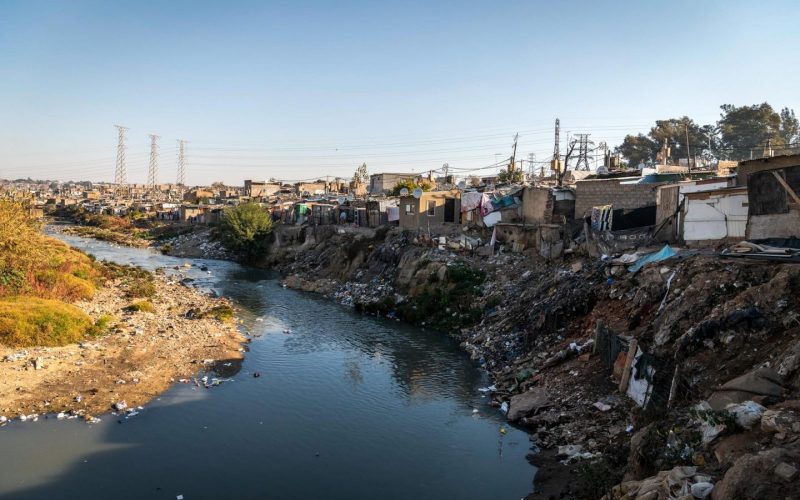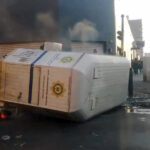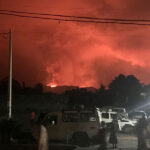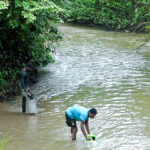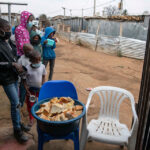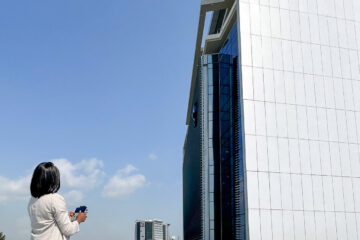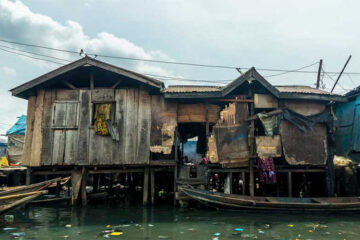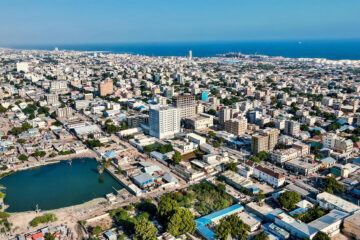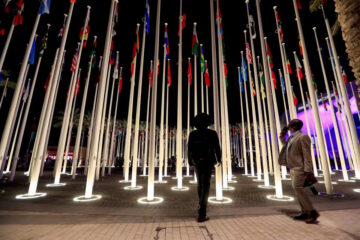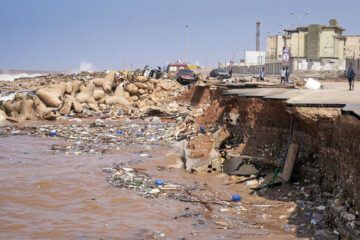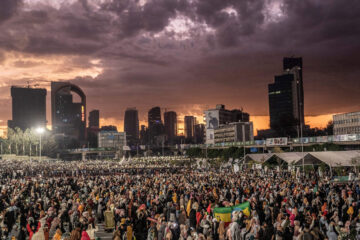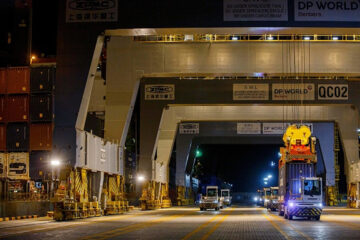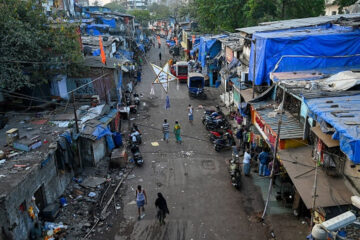ABOUT 1 600 families in the Stjwetla shack settlement in Johannesburg are standing on the verge of seismic change. This is the story of one of them.
DENNIS WEBSTER
The American poet GC Waldrep recently described gravity as “a debt … incurred by God”. In the Stjwetla shack settlement in Alexandra, Johannesburg, gravity is God sent. Built around a series of small rivulets that flow down the western bank of the Jukskei River in the township’s northeastern corner, it is a place where everything rolls downhill.

Some of the rivulets have been turned into concrete gutters, others run through the middle of dusty footpaths. But all of them stand in for the settlement’s lack of sanitation and services, transporting its waste into the river. The Jukskei accepts everything and denies nothing.
The trickle begins early in the morning when residents toss out the tubs of grey water used to wash dishes, laundry and their bodies. Others brush teeth, gargle and spit while the settlement wakes up around them. The sound is a mix of children in full voice and artisanal clanks: a carpenter hammering custom-made wardrobes, the hum of arc-welding machines as they fashion burglar bars, and the mending of fridges and televisions.

In a home alongside one of these streams, the morning din is mixed with the pitter-patter of sparrows’ feet. Gladys and Thandi Magxotywa’s shacks, which have denim-blue walls, are built in the shade of one of two oak trees that make up Stjwetla’s paltry canopy. Its branches are home to sparrows in the morning, and on some nights they hear the heavy thud of an owl relieving them of one of the chubby rats that scurry across their roof.
This home, with its L-shaped yard and concrete benches the colour of strawberry jam, is one among thousands that have been thrust into the Covid-19 spotlight by the government’s attempts to curb the spread of the virus in shack settlements.
The coming storm
The Magxotywas are among the 5 100 families who call Stjwetla home, according to the City of Joburg’s most recent count, and two among the almost one billion people who live in the world’s slums and shack settlements. Once the coronavirus pandemic started its planetary march, it didn’t take long for public health experts to point out that these are the areas least prepared for it.

By the end of the year, 1 600 of the homes in Stjwetla are set to be razed. In an effort to “de-densify” the settlement, the families will be moved into shipping containers on what are now two dusty patches of open land on the opposite end of Alexandra.
There has been at least one confirmed Covid-19 infection in Stjwetla. (A Gauteng Department of Health policy not to disclose the location of infections beyond the regional level makes it difficult to say whether the virus has spread any further in the settlement.) But any further devastation will likely have less to do with the coronavirus and more to do with what it lays bare.

When the virus arrived, three in every 10 Stjwetla homes used bucket toilets; the rest shared portable chemical toilets. Nine in 10 homes got their water from a communal tap. Only 12% of households in the settlement earned more than R3 500 a month; 14% had no income at all. Mapping of geographic vulnerability to the virus by the Council for Scientific and Industrial Research also suggests that Stjwetla is more exposed to infection than the township around it. Whereas all of Stjwetla has been classified as extremely vulnerable to the coronavirus, the same can be said of only 9% of Alexandra (the majority of the township is classified as either vulnerable or highly vulnerable).
The coronavirus could not imagine a petri dish more welcoming than the Stjwetla shack settlement. The City hopes that ensuring fewer people are living alongside one another will take some of the edge off the virus. But its intervention is also likely to threaten the settlement’s well-established social and economic networks and histories.
It remains unclear which of Stjwetla’s homes will be torn down. But the Magxotywas, having long been eligible for a state-subsidised home, will qualify for relocation.
Winters of delay
This will be Gladys’ 33rd winter in Stjwetla. Living so near to the water makes the cold inescapable. When the settlement thaws in the early mornings, the chill is body-built – coming from your lungs more than from the air around you. And in the evenings, many homes keep fires in perforated metal buckets. The smoky air turns every light on the opposite and more affluent eastern bank of the Jukskei into a star, until it seems that the sky is only a reflection of Alexandra.

She joined the church shortly after moving to Johannesburg as an 18-year-old to care for a young cousin. Her aunt was raising the children of the family whose home she kept as a domestic worker and had little time left for the newborn. Gladys is now 84, with smoke-white hair. “I have a big, hard life,” she said of the almost seven decades she has lived in the city. Her husband died in the early 1970s, and she has buried two sons since building her home in Stjwetla in 1987.
What makes a home is complicated; what keeps someone in it is even more so. For Gladys, first failure and then faith took their turns. After waiting nearly 20 years for the home the government had promised her, it appeared that charity might deliver where the state had failed. In 2014, Gift of the Givers built a small, neat neighbourhood of green shipping container homes nearby and offered one of them to Gladys. She refused it, however, and told New Frame it was because she would not be allowed to hang her ZCC portraits inside.
The puzzle of ‘de-densification’
The “de-densification” announced by the Department of Human Settlements, Water and Sanitation in response to the likely spread of the coronavirus in shack settlements has taken on some puzzling proportions. For one, it has been difficult to establish what the department means by it. There is, after all, no “de-densification” policy or legislation. Social movements feared it was shorthand for evictions; some housing officials hoped the moment might be leveraged for progressive interventions.
In practice, “de-densification” has meant different things in different places. More a verb than a government programme, officials are interpreting and implementing the national directive using existing housing instruments. Some interventions during the time of “de-densification” have seen families moved from shack settlements and into Wendy houses, while in Cape Town’s Dunoon, which along with Stjwetla is among the 29 settlements prioritised by the department for “de-densification”, homes have been demolished wholesale.
In Stjwetla, “de-densification” will officiate an uneasy marriage between the emergency housing programme (EHP) and the upgrading of informal settlements programme (UISP). The 1 600 families will be relocated using the EHP and the settlement will then be developed – improved services and eventually more secure tenure and better homes – using the UISP.

At the turn of the millennium, the government’s approach to shack settlements was one of “eradication”. When the UISP was introduced in 2004, it heralded a shift – in policy, if not practice – towards the participatory upgrading of their tenure security and infrastructure. Implementation of the UISP, however, has been notoriously slow. The upgrading of Slovo Park, south of Johannesburg, often seen as one of the policy’s success stories, began only when a court ordered the City to upgrade the settlement after decades of false starts.
In the past, upgrades were funded through a municipal grant called the urban settlements development grant (USDG). But, time and again, the grant was barely spent. In 2013, municipalities spent only 45% of the USDG funds they had been allocated. Three years later, that had increased only slightly to 57%. This chronic underspending necessitated the creation of a new funding instrument – the informal settlements development grant (ISDG) – that will come into effect in the next financial year.

Johannesburg was allocated just less than R2 billion of USDG funds for this year and will have an ISDG of about R400 million next year. Neo Goba, the deputy director of communications for the City’s housing department, told New Frame that his department is “still evaluating how much the development of Stjwetla will cost”, butearly plans for the upgrade suggest it could be anywhere between R128 million and R1.5 billion. That does not include the costs of relocation.
People vs the state
But for a beauty spot above Gladys’ lip, Thandi is ageing into her mother. Both have the same round face and deep cheek lines that make for stock expressions of concern. It is in their voices where they can be told apart. Thandi (more owl) speaks with a deep croak. Gladys’ sentences (more sparrow) trail off in high-pitched inflections.
But it is in their political outlooks where mother and daughter differ most. Gladys, despite being well versed in the grammar of broken promises, holds on to her belief that a government home is coming. Thandi, on the other hand, is not too old to have acquired aversions to the processes meant to deliver that home. A lifetime of losing has seen her hope slowly atrophy. She now nurses an abiding mistrust in promises. “I’m tired of government. They just do shit. And they do it with my signature,” she once told me of her decision to stop voting.

Poor spending, then, is not the only stumbling block to the upgrading of shack settlements. By the time upgrading projects eventually reach shack settlements, residents like Thandi have often lived through enough false hopes and forced evictions to have erased their faith in state interventions. In her own words: “This is my land. Leave me alone. That is my gate. I am a woman, but I built it with my own hands. If the government comes back, I will tell them to leave before I boil water in the kettle and throw it on them.”
When properly implemented, the UISP is designed to accommodate these tensions. Upgrades, so the thinking goes, should be co-productions in which communities take the lead in deciding their developmental needs. But, more than money, that sort of participation between local government and communities takes time. And the residents of Stjwetla may not have it. The UISP stipulates that people should be moved out of shack settlements as a measure of last resort, for instance, and only after lengthy engagements. While the City maintains that it has reached out to community leaders in Stjwetla, the decision to move 1 600 families out of the settlement appears to have been taken without ordinary residents being aware of it.

The dumping ground that became a town
Government relocations have been a part of Stjwetla’s DNA from its earliest days. The settlement is a long afterlife of the 1985 state of emergency. When Alexandra residents rose against the apartheid government’s increased clampdowns, it culminated in the bloodletting of a “Six Days War” in 1986. In the aftermath, 400 squatting families were removed to a “dumping ground” initially called Genisville (the town clerk at the time, Piet Genis, was central to the operation) but later renamed Stjwetla.
When Gladys arrived a year later, Stjwetla was still little more than a field of hip-high grass. She staked out her yard with poles and wire from a nearby dump, and put up the flimsy cardboard structure that would become the wooden home in which she is now seeing out her old age.
Gladys’ first shack went up just as apartheid’s influx control, which was abolished in 1986, came down. She stood, with countless others, on the verge of South Africa’s great urban migration. Alexandra’s population nearly tripled between 1985, when there was a shack for every brick house, and 1990, by which time the township’s shacks far outstripped its houses. Historians Noor Nieftagodien and the late Phil Bonner have noted that “the sheer scale of inward migration … created an unprecedented housing crisis” in Alexandra in the late 1980s.

The migration has not slowed. Between the national census in 2011 and a count conducted by the City in 2018, the number of homes in Stjwetla more than doubled. Today, yards the size of the Magxotywas’, much less grass, are no longer imaginable. The settlement’s throng of homes – from the cardboard structures of residents still struggling to establish a foothold to the double-storey brick walk-ups of those who have – has grown so diverse as to confound categorisation.
Over its four decades, Stjwetla has become the largest of the many Alexandra shack settlements, all of which have developed around water sources. Its banquet of built form hews so close to the bends of the Jukskei that, in places, it is difficult to distinguish between river and settlement, or to say whether one has grown from the other or birthed it. Plastic bags drifting lazily are the only sign of the currents masked by the river’s unfriendly olive-grey surface.
‘God will know’
On Alexandra’s far periphery, Stjwetla is geographically and economically a borderland. It is separated from opportunity by the arteries of Gauteng’s economy. Across the N3 highway in the east is the logistics hub of Linbro Park. Over the M1 highway to the west are Sandton’s glassy high-rises. And to the north, on the other side of the Gautrain, Midrand’s warehouses start.
Like all shack settlements, Stjwetla’s economy lives or dies on footfall and cash. And so, however barbaric the enforcement of Alexandra’s early lockdown – the settlement is a stone’s throw from where Collins Khosa was killed – stay-at-home orders have long since been ignored. Under level four, Stjwetla was open for business. Its narrow alleyways heaved with the impossibility of physical distancing and its economy of spaza shops, hot-food stalls, hairdressers and hustlers was in full swing.
The settlement’s arc is now almost four decades long. And while it may soon become clearer whether it bends towards development or destruction, it appears that the City’s “de-densification” raft is being built as it sails.

Stjwetlans scoff at the idea, for instance, that land could ever be cleared for development in the settlement without immediately being reoccupied by people in need of a home. To this, Goba said only that the City would “demarcate the area with barbed wire to avoid invasions”, warning residents that “we will not accept any lawlessness, and anyone who intends invading land and incomplete and unoccupied structures will face the full might of the law”.
Many residents are also wary of the timeline of an intervention supposed to spare them from a virus already at their doorstep. Available evidence suggests that the virus will peak in different provinces at different times, with Gauteng’s worst months expected to be July and August. Mlungisi Mabaso, the member of the City’s mayoral committee responsible for housing, has suggested that the earliest families could be moved out of the settlement is in September. When asked why his department was pursuing an intervention whose goal – easier physical distancing – would only be realised after the virus had passed its projected peak, Goba said“it would be premature for anyone to pre-empt when the virus pandemic will be at its peak”.
The coronavirus has brought a new gravity to Stjwetla. It remains to be seen if its downhill roll towards change will prove to be heaven sent or another debt in the settlement’s now heavy ledger. Gladys might say, “God will know.”


